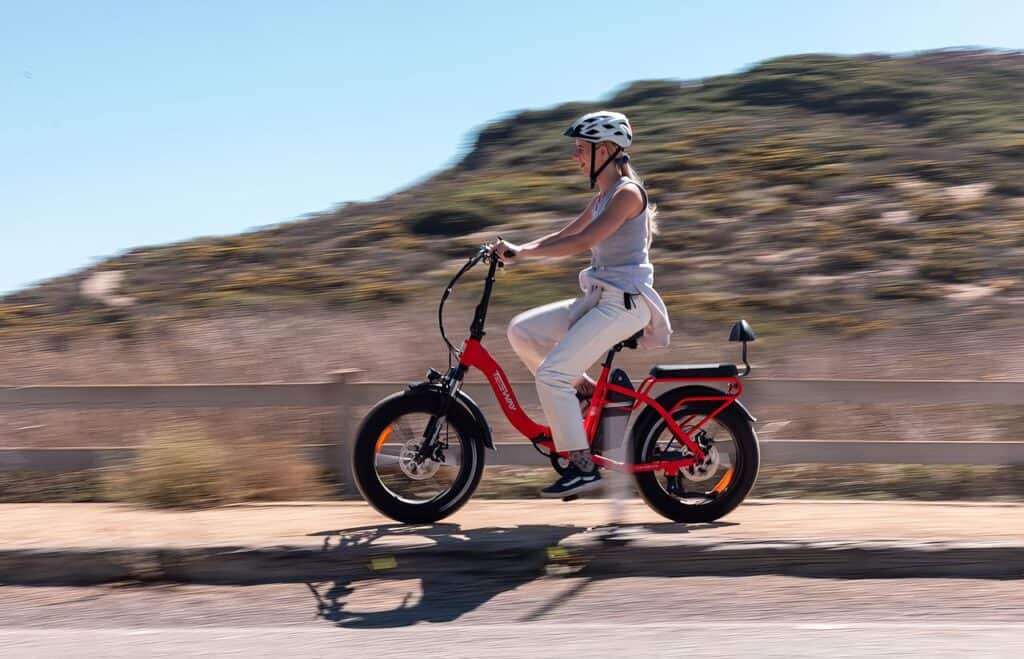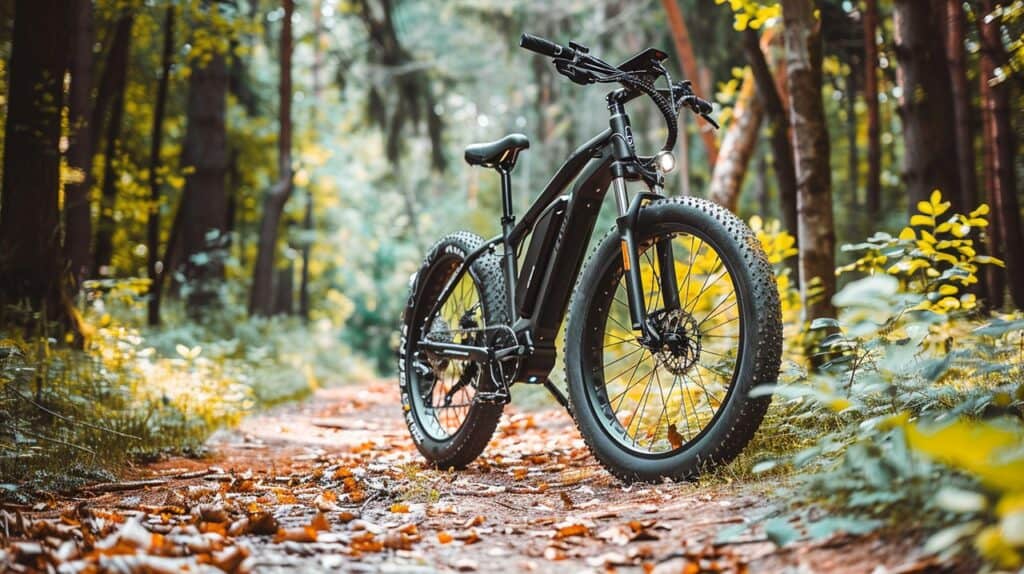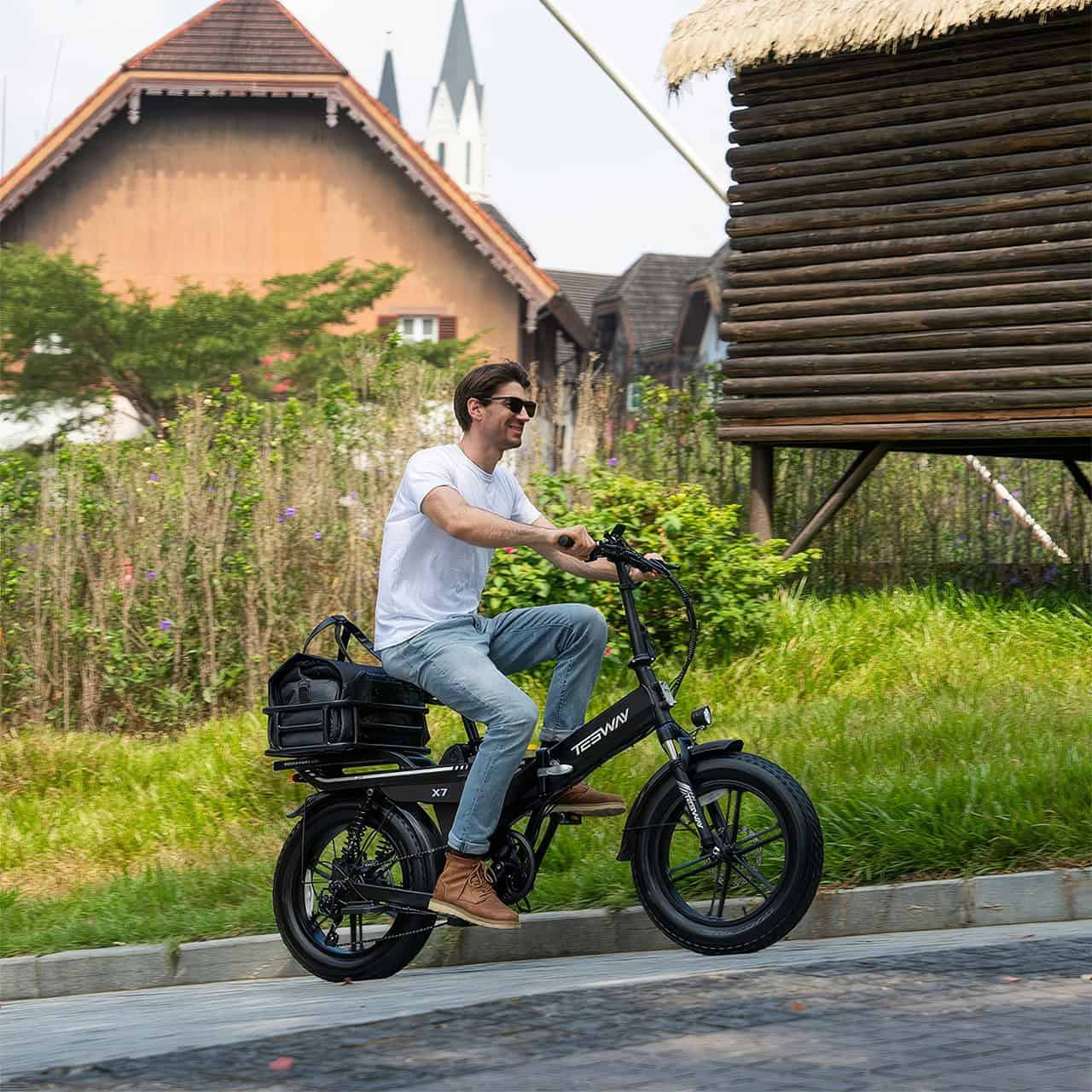Electric bikes revolutionize commuting. They last about 10 years with proper care. 2 This longevity depends on battery life, maintenance, and environmental factors. E-bikes use lithium-ion batteries, lasting 500 to 1000 charge cycles. 3
As an e-bike engineer with 15 years of experience, I’ve seen firsthand how proper maintenance extends their lifespan. 1 This guide offers practical tips to maximize your e-bike’s durability.
You’ll learn essential care techniques for key components.
Key Takeaways
Electric bikes typically last about 10 years with proper care and maintenance.
E-bike batteries usually last 3-5 years or 500-1000 charge cycles, but can be extended to 8 years with optimal storage and regular upkeep.
Key components like motors can last 10,000-20,000 miles, tires 1,000-3,000 miles, and chains 1-4 years depending on use and maintenance.
Regular maintenance, including monthly inspections and tune-ups every 500 miles, significantly extends an e-bike’s lifespan.
Proper battery care (keeping charge between 20-80%, storing in cool dry places) and smart riding habits (avoiding overloading, using appropriate power modes) help maximize an e-bike’s durability.
Table of Contents
Critical Components Impacting Electric Bike Longevity

Electric bikes rely on several key parts to function well. These components determine how long your e-bike will last and how it performs over time.
Ebike Motor Lifespan
E-bike motors pack serious staying power. Hub motors typically cruise for 10,000 to 15,000 miles—that’s 3 to 5 years of average use. Mid-drive motors push even further, potentially lasting beyond 20,000 miles.
Tesway ebikes, like many quality brands, offer motors designed to go the distance.
Motor longevity hinges on several factors. Quality components and regular maintenance significantly extend a motor’s life. Riding conditions play a role too—smooth roads are kinder than rough terrain.
With proper care, most well-made e-bike motors should hit the 10,000-mile mark. That’s a lot of pedal-assisted adventures.
A well-maintained e-bike motor is the heart of your ride, powering you through thousands of miles of exploration and fun.
Lifespan of Electric Bike Batteries
E-bike batteries, typically lithium-ion, pack a punch with 500 to 1000 charge cycles.2 These powerhouses last 3 to 5 years on average, delivering 800 to 1000 charges. Higher voltage options, like 52V batteries, offer extended life and improved performance.
Proper care can stretch battery life up to 8 years, maximizing your investment. 3
Optimal storage and regular maintenance significantly impact battery longevity. Keep your e-bike battery in a cool, dry place to prevent corrosion and electrolyte damage. Avoid overcharging or complete discharge – aim for 20-80% charge levels.
Clean contacts, inspect for wear, and use the manufacturer’s charger to preserve battery health and extend its lifespan.
Durability of Electric Bike Tires
Moving from battery life to tire durability, e-bike riders need to focus on their wheels. Electric bike tires typically last 1,000 to 3,000 miles, or 1 to 3 years of regular use. 4 Proper inflation is key for longevity.
High-quality tires can significantly boost an e-bike’s lifespan and performance. 2
Upgrading to premium rubber compounds and puncture-resistant materials pays off. These tires handle the extra weight and speed of e-bikes better, reducing wear. Regular inspections for cuts, embedded debris, and tread depth help catch issues early.
Rotating tires evens out wear patterns, extending their useful life on the road.
Performance of Electric Bike Brakes
Electric bike brakes play a crucial role in rider safety and performance. Rim brakes, common on entry-level e-bikes, last 1 to 3 years with regular use. 1 Disc brakes, found on higher-end models, offer superior stopping power and longevity, lasting 3 to 5 years or more.
Brake pads and rotors wear down over time, typically needing replacement every 3,000 to 6,000 miles depending on riding conditions and maintenance.
Good brakes don’t just stop your bike, they give you the confidence to ride faster and explore further.
Regular inspection and maintenance of brake calipers, pads, and rotors ensure optimal performance and extend the lifespan of your e-bike’s braking system. Proper lubrication and adjustment of brake components prevent premature wear and maintain consistent stopping power.
Next, we’ll explore the wear and tear of electric bike chains and their impact on overall durability. 2
Wear and Tear of Electric Bike Chains
E-bike chains face significant stress, especially on mid-drive motors. The Tesway X7 ebike’s chain might need replacement after 1,000 miles. 4 Chain lifespan varies from 1-4 years, heavily influenced by maintenance. 4 Regular lubrication and cleaning extend chain life dramatically.
Proper care prevents premature wear. Chains stretch over time, affecting gear shifting and overall performance. Riders should check chain tension monthly and adjust as needed. Replace chains showing visible wear or elongation to protect other drivetrain components. 2
Reliability of Electric Bike Displays
Moving from chain maintenance to display reliability, e-bike screens face unique challenges. Displays endure constant vibrations, weather exposure, and potential impacts. Durability varies widely based on quality and design.
High-end models often feature robust, water-resistant screens with scratch-resistant coatings. These displays typically last 3-5 years with proper care. 2 Budget options may need replacement sooner due to pixel failures or moisture damage.
Regular cleaning and protection from extreme temperatures extend display life. Firmware updates improve functionality and fix bugs. Timely repairs prevent minor issues from escalating.
Avoiding shocks and applying screen protectors safeguard against physical damage. Quality displays enhance the riding experience through accurate data and clear visuals, making them a crucial component for long-term e-bike enjoyment. 5
Key Factors That Affect Electric Bike Durability

Your e-bike’s lifespan hinges on several key factors. Regular upkeep, quality parts, and riding conditions all play crucial roles in determining how long your electric bike will last.
Maintenance Frequency and Electric Bikes
Regular maintenance is key to extending your e-bike’s life. Proper upkeep prevents small issues from becoming big problems. E-bikes need more frequent checks than traditional bikes due to their complex components. 1
An ounce of prevention is worth a pound of cure.
Experts recommend monthly inspections and tune-ups every 500 miles. This includes checking tire pressure, cleaning the chain, and tightening bolts. Battery care is crucial – keep it charged between 20-80% and store it in a cool, dry place.
Lubricate moving parts regularly to reduce wear and tear. These simple steps can significantly boost your e-bike’s performance and longevity. 2
Component Quality and Electric Bike Durability
High-quality components significantly boost e-bike durability. Premium lithium-ion batteries, robust motors, and sturdy frames extend the lifespan of electric bicycles. The Tesway X5 ebike, for example, uses top-tier parts to ensure longevity.
Corrosion-resistant materials and carbon fiber elements resist wear and tear, especially in harsh environments. 2
Superior components also improve performance and safety. Reliable brakes, durable tires, and advanced displays enhance the riding experience. Quality parts reduce maintenance frequency, saving time and money.
E-bikes with premium components often last 5-10 years with proper care, compared to 3-5 years for budget models. 6
Environmental Impact on Electric Bikes
Quality components in e-bikes contribute to their durability and eco-friendliness. Environmental factors also play a crucial role in their overall impact. E-bikes emit 10 times less CO₂ than gasoline vehicles throughout their lifespan. 7 This significant reduction in emissions makes them a greener transportation option. Li-ion batteries, while essential for e-bike function, have the highest environmental impact due to materials like lithium, cobalt, nickel, and graphite. 8 Proper recycling of old e-bike batteries is vital for sustainability. It conserves resources and limits air and water pollution. Riders can minimize their environmental footprint by choosing e-bikes with recyclable components and participating in battery recycling programs.
Tips to Extend Your Electric Bike’s Lifespan

Proper care extends your e-bike’s life. Keep reading for essential tips on battery care, regular upkeep, and smart riding habits.
Care and Storage of Ebike Batteries
Proper care and storage of ebike batteries significantly extend their lifespan. Follow these guidelines to maximize your battery’s performance and longevity:
- Charge level: Store batteries at 40-80% capacity for optimal longevity. Avoid full discharges. 9
- Temperature control: Keep batteries in 50-77°F (10-25°C) environments. Extreme heat or cold damages cells.
- Regular use: Ride your Tesway S5 ebike frequently. Inactivity can lead to battery degradation.
- Partial charges: Top up often rather than waiting for complete discharge. This preserves battery health.
- Clean connections: Wipe battery terminals with a dry cloth to ensure good contact.
- Avoid moisture: Store in dry areas. Humidity can corrode components.
- Secure mounting: Ensure the battery is firmly attached to prevent vibration damage.
- Use original charger: Stick to manufacturer-provided chargers for safety and efficiency.
- Slow charging: Opt for standard charging over fast charging to reduce stress on the battery. 10
- Storage preparation: Charge to 50% before long-term storage. Recharge every 3 months.
Routine maintenance plays a crucial role in preserving your ebike’s overall condition.
Routine Maintenance for Electric Bikes
Proper care of e-bike batteries sets the foundation for overall maintenance. Regular upkeep of your electric bike ensures optimal performance and longevity.
- Check tire pressure weekly. Inflate to recommended PSI for smooth rides and energy efficiency.
- Inspect brake pads monthly. Replace when worn to 1/4 inch thickness for safety and quick stops.
- Lubricate chain every 100 miles. Use bike-specific lubricants to reduce friction and extend drivetrain life. 12
- Clean frame and components after muddy rides. Use a damp cloth to prevent dirt buildup and maintain appearance.
- Tighten loose bolts and screws monthly. Focus on handlebars, stem, and seat post to prevent wobbling.
- Test lights and signals before night rides. Replace batteries or bulbs promptly for visibility and safety.
- Schedule professional tune-ups annually. Experts can catch issues you might miss and keep your e-bike ready to go fast. 11
Proper Handling and Usage of Electric Bikes
Proper handling and usage of an electric folding bicycle ensures safety and longevity. Here are key tips for maximizing your e-bike’s performance and lifespan:
- Charge smartly: Plug in your e-bike when the battery level drops to 20-30%. Avoid full discharges to preserve battery life. 2
- Store safely: Keep your e-bike in a dry, cool place. Extreme temperatures can damage the battery and electrical components.
- Clean regularly: Wipe down your e-bike after rides. Use a damp cloth to remove dirt and debris from the frame and components.
- Lubricate moving parts: Apply bike-specific lubricant to the chain, gears, and other moving parts every 100-200 miles.
- Check tire pressure: Maintain proper tire inflation for optimal performance and reduced wear. Check pressure weekly.
- Use appropriate power modes: Match power assist levels to terrain and riding conditions. Overusing high power modes drains the battery faster.
- Avoid overloading: Stay within the weight limits specified by the manufacturer. Excess weight strains the motor and battery.
- Brake gradually: Apply brakes smoothly to reduce wear on brake pads and rotors. Avoid sudden stops when possible.
- Protect from theft: Use a high-quality U-lock or chain lock when parking your e-bike in public areas.
- Schedule professional maintenance: Have your e-bike serviced by a qualified technician annually or every 1,000 miles.
- Update firmware: Keep your e-bike’s software up-to-date for optimal performance and security.
- Handle with care: Lift your e-bike by the frame, not the battery or motor. Avoid dropping or jarring the bike.
- Use proper charging equipment: Stick to the charger provided by the manufacturer. Aftermarket chargers may damage the battery.
- Ride responsibly: Follow traffic laws and bike path etiquette. Safe riding prevents accidents and extends your e-bike’s life.
- Store battery separately: If not using your e-bike for extended periods, remove and store the battery at 40-60% charge. 13
People Also Ask
How long do electric bike batteries last?
Lithium-ion batteries in e-bikes typically last 3-5 years. Proper care extends life. Avoid quick charges, extreme temps. Regular use helps. Lithium polymer batteries may offer longer life.
Can I improve my e-bike’s lifespan?
Yes! Maintain the battery, electrical engine, and transmission. Use a good bike lock. Clean regularly. Avoid water damage. Store in a dry place. Regular check-ups help.
Does riding style affect e-bike longevity?
Absolutely. Gentle pedaling extends battery life. Avoid constant full-power use. Mix physical activity with motor assist. It’s good for the bike and your fitness.
How often should I charge my e-bike?
Charge after each ride, if possible. Don’t let the battery drain completely. Avoid overcharging. Lithium-ion batteries don’t have a memory effect. Partial charges are fine.
What parts need most attention for longevity?
Focus on battery, motor, and bottom bracket. Keep chain clean, lubed. Check tire pressure often. Protect from weather. Regular service by pros helps maximize lifespan.
References
- ^ https://haoqiebike.com/blogs/news/how-long-do-electric-bikes-last-everything-you-need-to-know
- ^ https://www.biktrix.com/blogs/the-biktrix-blog/how-long-do-electric-e-bike-last (2024-06-24)
- ^ https://reallygoodebikes.com/blogs/electric-bike-blog/how-long-does-an-e-bike-battery-last (2024-02-21)
- ^ https://himiwaybike.com/blogs/news/electric-bike-component-durability (2023-10-11)
- ^ https://www.ncbi.nlm.nih.gov/pmc/articles/PMC9546252/
- ^ https://nakto.com/blogs/nakto-stories/understanding-electric-bike-component-durability
- ^ https://upway.co/blogs/news/environmental-impact-of-e-bikes
- ^ https://www.railstotrails.org/wp-content/uploads/2024/02/Electric-Bicycle-E-bike-Trends-Impacts-and-Opportunities-Literature-Review-Summary-.pdf
- ^ https://pedegoelectricbikes.ca/3-ways-to-prolong-your-electric-bike-battery/
- ^ https://leedsbikes.com/blog/extend-life-e-bike-battery/
- ^ https://bandit.bike/blogs/articles/how-long-does-an-e-bike-last-a-comprehensive-guide-to-e-bike-longevity
- ^ https://metriders.com/blogs/knowledge/how-to-make-your-electric-bike-last-longer-essential-maintenance-tips
- ^ https://www.consumerreports.org/health/electric-bikes/how-to-make-your-e-bike-last-longer-a9368348989/ (2024-04-19)




